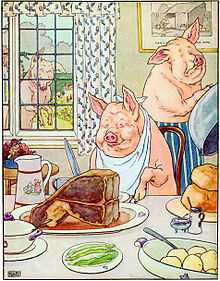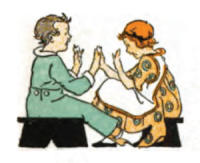This Little Piggy
| "This Little Piggy" | |
|---|---|
| Roud #19297 | |
 This Little Pig Went to Market by Lilly Martin Spencer, 1857 | |
| Written by | Traditional |
| Published | 1760 |
| Written | England |
| Language | English |
| Form | Nursery rhyme |
"This Little Piggy" or "This little pig" is an English language nursery rhyme and fingerplay. It has a Roud Folk Song Index number of 19297.
Lyrics

The most common modern version is:
- This little piggy went to the market,
- This little piggy stayed home,
- This little piggy had roast beef,
- This little piggy had none,
- And this little piggy cried wee wee wee all the way home.[2]
Another version often cited is:
- This little piggy went to market,
- This little piggy stayed home,
- This little piggy had jam and bread,
- This little piggy had none,
- And this little piggy went crying all the way to town[3]
Finger play

The rhyme is usually counted out on a person's toes, each line corresponding to a different toe, usually starting with the big toe and ending with the little toe. A foot tickle is usually added during the "Wee...all the way home" section of the last line.[citation needed] The rhyme can also be seen as a counting rhyme, although the number of each toe (from 1 for the big toe to 5 for the little toe) is never stated.[citation needed]
Origins
The first line of this rhyme was quoted in a medley "The Nurse's Song," written about 1728, a full version was not recorded until it was published in The Famous Tommy Thumb's Little Story-Book, published in London about 1760.[4] It then appeared with slight variations in many late eighteenth and early nineteenth century collections. Until the mid-twentieth century the lines referred to "little pigs."[4]
References
- ↑ Wentworth. Work and Play with Numbers. p. 14.
- ↑ Herman, D. (2007). The Cambridge Companion to Narrative. Cambridge: Cambridge University Press. p. 9.
- ↑ Rizzo, C. (1995). All the Ways Home: Parenting and Children in the Lesbian and Gay Communities. Norwich VT: New Victoria Publishers. p. 104.
- ↑ 4.0 4.1 Opie, I.; Opie, P. (1951). The Oxford Dictionary of Nursery Rhymes (1997 ed.). Oxford University Press. pp. 349–50.
Bibliography
- Wentworth, George; Smith, David Eugene (1912). Work and Play with Numbers. Boston: Ginn & Company.
- Brewster, Paul G. (1976). Children's Games and Rhymes. Ayer Co Pub. ISBN 978-0405079146.
| |||||||||||||||||||||||||||||||
